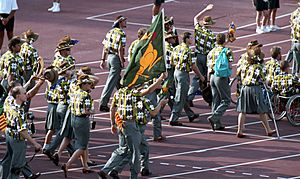1992 Summer Paralympics facts for kids
The 1992 Summer Paralympics were a huge sports event held in Barcelona, Spain. These games brought together 3,001 amazing athletes from 83 different countries. Athletes with various disabilities competed, showing incredible skill and determination. The types of disabilities included spinal injuries, amputations, blindness, cerebral palsy, and a group called "Les Autres" (which means "the others"). The Paralympics are like the Olympic Games, but they are specially for athletes with disabilities. They happen right after the Olympic Games in the same host city.
Contents
What Are the Paralympic Games?
The Paralympic Games are a major international multi-sport event. They involve athletes with a range of physical disabilities. These games happen every four years. They are held after the Olympic Games. The goal is to give athletes with disabilities a chance to compete at the highest level.
History of the Paralympics
The idea for the Paralympics started after World War II. It was a way to help injured soldiers. Dr. Ludwig Guttmann organized a sports competition in 1948. This was for British veterans with spinal cord injuries. These games grew over time. They became the Paralympic Games we know today.
Why Are the Paralympics Important?
The Paralympic Games are very important. They show the world what people with disabilities can achieve. They promote inclusion and equality. Athletes inspire millions of people. They prove that anything is possible with hard work.
Barcelona 1992: A Special Event
The 1992 Summer Paralympics were held in Barcelona. This city also hosted the Summer Olympic Games that year. Holding both events in the same city was a big step. It helped to bring more attention to the Paralympic Games.
Athletes and Countries
Over 3,000 athletes came to Barcelona. They represented 83 different nations. This was a record number of participants at the time. It showed how much the Paralympic movement was growing. Athletes competed in many different sports.
Types of Disabilities at the Games
Athletes were grouped by their disability. This made sure competitions were fair.
- Spinal Injury: Athletes with injuries to their spinal cord. This can affect how they move their legs or arms.
- Amputee: Athletes who have lost a limb, like an arm or a leg. They often use prosthetics (artificial limbs) to compete.
- Blindness: Athletes who are blind or have very limited vision. They might use guides or special equipment.
- Cerebral Palsy: Athletes with a condition that affects muscle control. This can make movements difficult.
- Les Autres: This group included athletes with other physical disabilities. These might not fit into the main categories. Examples could be dwarfism or multiple sclerosis.
Sports and Competition
The 1992 Games featured many exciting sports. Athletes competed in events like swimming, athletics (track and field), basketball, and more. Each sport had rules adjusted for different disability groups. This allowed everyone to compete fairly. The athletes trained hard for years. They showed amazing strength and dedication.
Impact of the Games
The Barcelona Games were a big success. They helped to raise awareness about disability sports. They also inspired many young people with disabilities. The games showed the world the power of sport. They highlighted the incredible abilities of Paralympic athletes.
See also
 In Spanish: Juegos Paralímpicos de Barcelona 1992 para niños
In Spanish: Juegos Paralímpicos de Barcelona 1992 para niños


